If I were to ask you to describe the San Jose Earthquakes over the last half-decade, you would probably be caught between "unremarkable" and "The Goonies!" The Quakes found intermittent success, but their style was predicated on Chris Wondolowski's consistency and those "Never say die!" last-minute flurries. In 2018, however, under new head coach Mikael Stahre, we are seeing a new San Jose team. Instead of the straightforward approach of old, the best word to describe them appears to be innovative. The Quakes were the most interesting tactical team in Week 1.
The Quakes morphed between a 4-2-3-1 and an unorthodox 4-2-2-2 in their MLS Opening Weekend victory over Minnesota United FC. It created a template that proved to be both efficient and exciting.
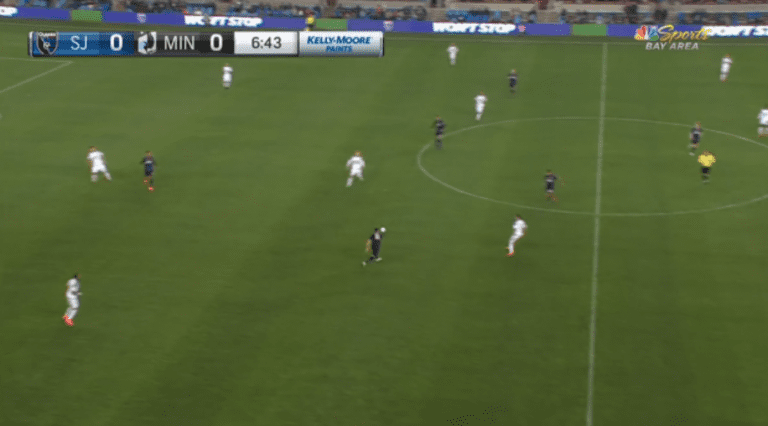
San Jose (attacking toward the left goal) in a defensive 4-2-3-1. | MLSsoccer.com
When in their defensive shape (See above), the Quakes played a 4-2-3-1 with Danny Hoesen in front of Magnus Eriksson, Wondo, and Vako, and Florian Jungwirth and Anibal Godoy as the defensive midfielders. When in possession in their own half, as well, the attackers would line up in a similar fashion with Wondo behind Hoesen, and Vako and Eriksson wide.
As they moved the ball forward, then, they shifted into a 4-2-2-2, with Vako and Erikson trying to find the central openings:
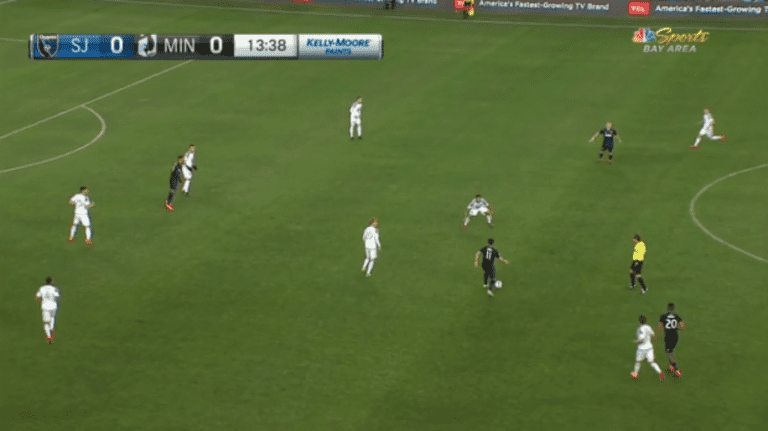
San Jose's attack beginning to centralize. | MLSsoccer.com
The 4-2-2-2 provides variation against the 4-2-3-1 and 3-5-2 that dominate MLS play. Last season, the New York Red Bulls played a 4-2-2-2 at times, for a different reason; the Red Bulls built their 4-2-2-2 around the defensive side of the ball, aligning their lines to best suit their defensive shifting. The Quakes, conversely, use the central emphasis for attacking purposes.
The middle of the formation – the "2-2" linking the back line and the forward – sets up like a box. Two defensive midfielders, Jungwirth and Godoy, played behind two attacking players, Eriksson and Vako. In the snapshots below, we can see the intentional rotation as the ball moves forward.
Vako is at the bottom of your screen in the first picture and pinches in by the second, taken three seconds later. As the Quakes continue to maintain possession over the next ten seconds, Erikson – who started at the far sideline (top), pinches in from the far side, as seen in the third picture. Over the 13 seconds, San Jose's shape shift from a 4-2-3-1 with the wingers wide, to a 4-2-2-2 with both wide attackers pinched centrally to find the ball.
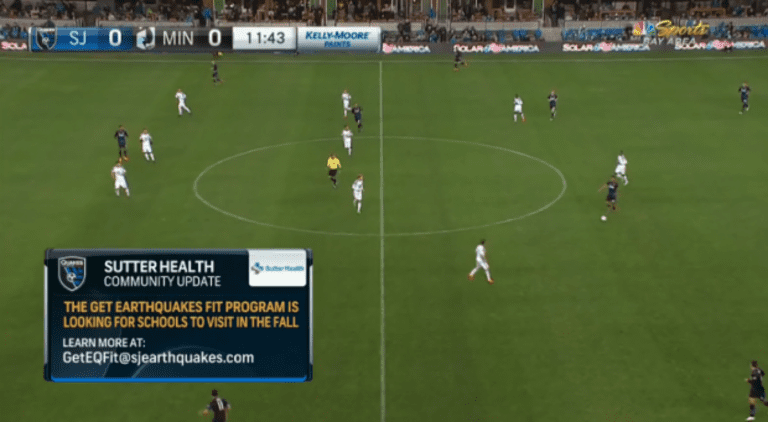
San Jose shifts to the attack, from a 4-2-3-1. | MLSsoccer.com
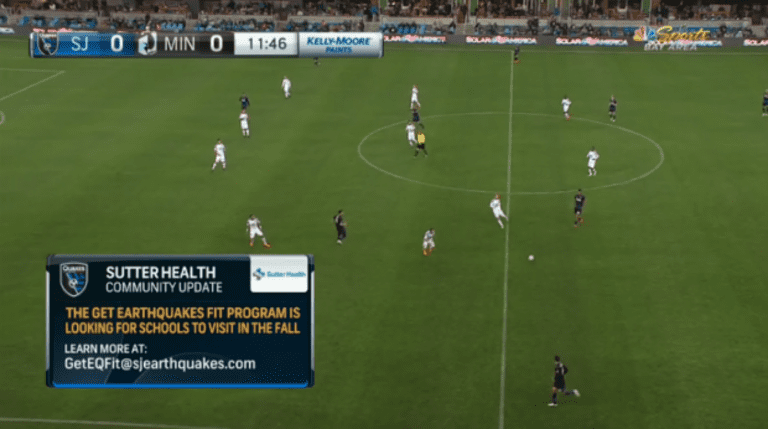
San Jose's wide midfielders begin to pinch. | MLSsoccer.com
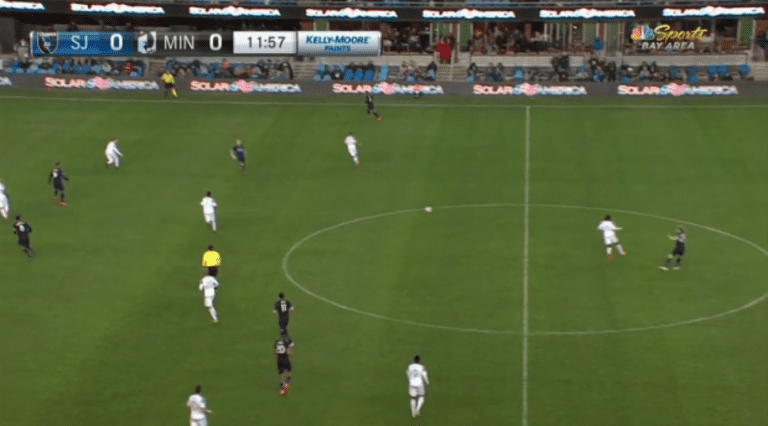
San Jose's shape has changed to a 4-2-2-2. | MLSsoccer.com
The box midfield that results offers two advantages:
- It gets numbers around the ball, while providing – with discipline – strong support in defense.
- It's uncommon in MLS.
Simply put, more numbers equals more options. As the old saying about possession goes, (passing) triangles are good; there are more triangles within four points of intersection than within three points. If you want to be a passing team, you need options around the ball.
The counter point would be that the box leaves too many gaps on other parts of the field. If all of the players are central and looking for the ball, then who stretches the game wide? For San Jose, it was the outside backs. Shea Salinas and Nick Lima, both fit players, got up and down the sideline throughout the game.
If you're worried about the defense with both outside backs racing forward, the box also has you covered: You don't just have a box in the midfield, you also have a box in your defensive structure, formed by the two center backs and the two defensive mids.
In some systems that use a double pivot with the defensive mids, they ask one of the defensive midfielders to attack and the other to provide the cover. The box midfield generally demands that both players hold back and maintain the discipline of the team. The defensive box of four then, provides the numerical advantage on counters in the same way three defenders and a defensive midfielder would. (I tried to find a still image of this from the game, but cameras generally care more about the ball than solid defensive structure behind the play.)
For the Quakes' new system, this is the part that concerns me the most. Both Godoy and Jungwirth like to find the ball and play attractive soccer; either through Stahre's instructions or personal style, neither seems particularly keen to prioritize discipline over all else. There could be moments when they leave those key positions and the Quakes are exposed on the counter.
The second advantage of the box comes from its relative rarity. It provides an unconventional rotation from the attacking players. The Quakes want to accomplish roughly the same thing every other soccer team wants – combinations around the box, crosses from good areas, players making good runs, etc – but they come at it from slightly different starting positions.
It's subtle, but much like in chess – where a non-traditional move can send the master spiraling as he struggles to picture the board – athletes develop mental images and muscle memory that responds to a certain flow of movement. Since most MLS teams play some with form of a striker, an attacking midfielder or withdrawn forward, plus two wingers, most attacking movement looks similar.
But the Quakes essentially deploy two attacking midfielders plus Wondo (something of an attacking mid with a free role) plus a striker. Throw in the overlapping fullbacks and it creates six options around the ball in central areas – not a picture most defenders have seen. Consequently, it forces defenders to use an extra half-second to think.
The Quakes want the same thing everyone else does in the attacking third, but in going about it a different way, they gain an advantage. Innovation can be powerful. And interesting to watch.
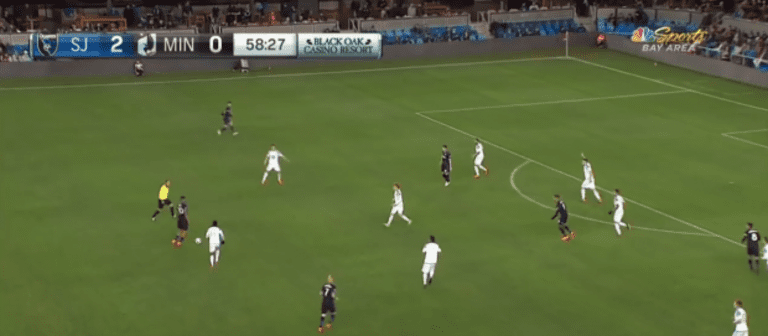
San Jose's shift has resulted in six players pressing the attack toward the right goal. | MLSsoccer.com













